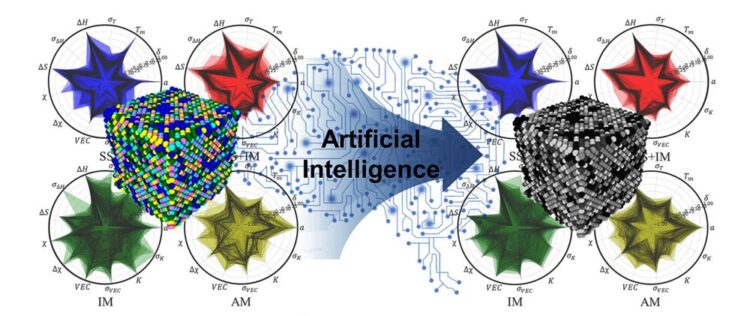AI speeds up development of new high-entropy alloys

New materials that apply AI to develop high-entropy alloys (HEAs) which are coined as alloy of alloys
Credit: Seungchul Lee (POSTECH)
Developing new materials takes a lot of time, money and effort. Recently, a POSTECH research team has taken a step closer to creating new materials by applying AI to develop high-entropy alloys (HEAs) which are coined as “alloy of alloys.”
A joint research team led by Professor Seungchul Lee, Ph.D. candidate Soo Young Lee, Professor Hyungyu Jin and Ph.D. candidate Seokyeong Byeon of the Department of Mechanical Engineering along with Professor Hyoung Seop Kim of the Department of Materials Science and Engineering have together developed a technique for phase prediction of HEAs using AI. The findings from the study were published in the latest issue of Materials and Design, an international journal on materials science.
Metal materials are conventionally made by mixing the principal element for the desired property with two or three auxiliary elements. In contrast, HEAs are made with equal or similar proportions of five or more elements without a principal element. The types of alloys that can be made like this are theoretically infinite and have exceptional mechanical, thermal, physical, and chemical properties. Alloys resistant to corrosion or extremely low temperatures, and high-strength alloys have already been discovered.
However, until now, designing new high-entropy alloy materials was based on trial and error, thus requiring much time and budget. It was even more difficult to determine in advance the phase and the mechanical and thermal properties of the high-entropy alloy being developed.
To this, the joint research team focused on developing prediction models on HEAs with enhanced phase prediction and explainability using deep learning. They applied deep learning in three perspectives: model optimization, data generation and parameter analysis. In particular, the focus was on building a data-enhancing model based on the conditional generative adversarial network. This allowed AI models to reflect samples of HEAs that have not yet been discovered, thus improving the phase prediction accuracy compared to the conventional methods.
In addition, the research team developed a descriptive AI-based HEA phase prediction model to provide interpretability to deep learning models, which acts as a black box, while also providing guidance on key design parameters for creating HEAs with certain phases.
“This research is the result of drastically improving the limitations of existing research by incorporating AI into HEAs that have recently been drawing much attention,” remarked Professor Seungchul Lee. He added, “It is significant that the joint research team’s multidisciplinary collaboration has produced the results that can accelerate AI-based fabrication of new materials.”
Professor Hyungyu Jin also added, “The results of the study are expected to greatly reduce the time and cost required for the existing new material development process, and to be actively used to develop new high-entropy alloys in the future.”
###
This research was supported by the National Research Foundation’s Mid-Career Researcher Program, the High-Potential Individuals Global Training Program of Korea’s Institute for Information and Communications Technology Promotion (IITP), and the Development of Meta-Silicide Thermoelectric Semiconductor and Metrology Standardization Technology of Thermoelectric Power Module of the Korea Institute of Energy Technology Evaluation and Planning (KETEP).
Media Contact
Jinyoung Huh
jyhuh@postech.ac.kr
82-542-792-415
Original Source
http://www.
Related Journal Article
All latest news from the category: Materials Sciences
Materials management deals with the research, development, manufacturing and processing of raw and industrial materials. Key aspects here are biological and medical issues, which play an increasingly important role in this field.
innovations-report offers in-depth articles related to the development and application of materials and the structure and properties of new materials.
Newest articles

NASA: Mystery of life’s handedness deepens
The mystery of why life uses molecules with specific orientations has deepened with a NASA-funded discovery that RNA — a key molecule thought to have potentially held the instructions for…

What are the effects of historic lithium mining on water quality?
Study reveals low levels of common contaminants but high levels of other elements in waters associated with an abandoned lithium mine. Lithium ore and mining waste from a historic lithium…

Quantum-inspired design boosts efficiency of heat-to-electricity conversion
Rice engineers take unconventional route to improving thermophotovoltaic systems. Researchers at Rice University have found a new way to improve a key element of thermophotovoltaic (TPV) systems, which convert heat…



